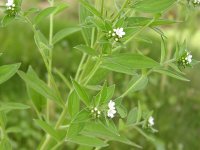Red-breasted burrows - lithospermum crythrorhizon l.
Family Burachnichkovye - Boraginaceae
Botanical characteristics. Herbaceous perennial plant. It grows on dry stony slopes, among bushes, along roadsides.
The root is thick, thick, dark red. Stem straight up to 50 cm high, covered with bristly hairs. Leaves lanceolate with pronounced middle and lateral veins. The flowers are white, located in the axils of the upper leaves, collected in multi-flowered curls. Fruit is a light brown smooth shiny oval nut. Blossoms in June - July, fructifies in July - August.
Used parts of the plant. The medicinal raw material is the entire plant, more often flowers and leaves. The plant is pulled out with a root during flowering, dried in bundles under an open ventilated canopy. The roots are ground and dried in dryers at a temperature of no higher than 40 ° C.
Chemical composition. All parts of the plant contain shikonin and its derivatives, pigments, carbohydrates. The roots contain lithospermans, cyclitols, their derivatives, caffeic acid esters and higher aliphatic alcohols, flavonoids, naphthoquinones, waxes. Leaves and flowers contain phenolic carboxylic acids (lithosperm, coffee), derivatives of naphthoquinones, vitamins. In seeds - fatty oil, in its composition, organic acids.
Application. Roots and aerial parts in the form of decoctions and infusions are used as an antitumor agent. Shikonin and its derivatives in the experiment have an antigonadotropic and antiviral effect of a broad spectrum, exhibit antibacterial activity against dysentery amoeba.
In Tibetan, Chinese, Korean and Japanese medicine, medications are used for various infectious and viral diseases, mainly with scarlet fever, measles, chicken pox, flu, diseases accompanied by a rash; As a means of stimulating the function of the gonads, with impotence, in gynecology in inflammatory processes with arthritis and other diseases of rheumatoid nature; As an antidote for biting poisonous insects, animals, but mostly snakes; As a preventive tool for epidemics of infectious diseases, restorative, antipyretic and diuretic. Outer in the form of ointments and lotions for tumors of various etiologies, cuts, bruises, burns, frostbite, eczema, chronic non-healing wounds and ulcers. Fresh juice and an infusion of fresh plants are an effective tool for baldness, promote the growth and strengthening of hair. Decoction of the roots has a contraceptive property.
Preparation
- To prepare the broth take 15 g of roots, grind, pour 180 ml of boiling water, insist on a boiling water bath for 30 minutes, cool 10 minutes, filter, bring to 180 ml. Take a decoction of 2 tbsp. Spoon 3-4 times a day after meals.
- From the leaves and flowers prepare the infusion as follows: 20 g of crushed leaves or flowers, or mixtures thereof, pour 200 ml of boiling water, insist on the bath for 15 minutes, cool at room temperature for 45 minutes, filter, bring to the desired volume. Take 1/3 cup 3 times a day.




Comments
When commenting on, remember that the content and tone of your message can hurt the feelings of real people, show respect and tolerance to your interlocutors even if you do not share their opinion, your behavior in the conditions of freedom of expression and anonymity provided by the Internet, changes Not only virtual, but also the real world. All comments are hidden from the index, spam is controlled.